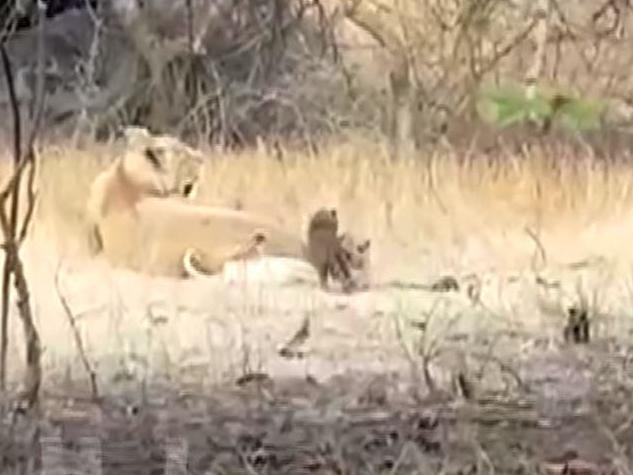Lioness adopts leopard cub and ‘cares for it like her own’
This is only the third interspecies adoption by niche competing species recorded in the wild

The lions and leopards of Gir National Park, in Gujarat, India, normally do not get along.
“They compete with each other” for space and food, said Stotra Chakrabarti, a postdoctoral researcher at the University of Minnesota who studies animal behaviour. “They are at perpetual odds.”
But about a year ago, a young lioness in the park put this enmity aside. She adopted a baby leopard.
The two-month-old cub – all fuzzy ears and blue eyes – was adorable, and the lioness spent weeks nursing, feeding and caring for him until he died. She treated him as if one of her own two sons, who were about the same age. This was a rare case of cross-species adoption in the wild, and the only documented example involving animals that are normally strong competitors, Dr Chakrabarti said. He and others detailed the case last week in the ecology journal Ecosphere.
The paper’s authors, who also included a conservation officer and a park ranger, first spotted the motley crew in late December 2018, hanging out near a freshly killed nilgai antelope.
Initially, they thought the association would be brief; a lioness in Tanzania’s Ngorongoro Conservation Area had once been observed nursing a leopard cub, but only for a day before the two separated.
“But this went on,” Dr Chakrabarti said.
For a month and a half, the team watched the mother lion, her two cubs and the leopard roam Gir National Park. “The lioness took care of him like one of her own,” nursing him and sharing meat that she hunted, Dr Chakrabarti said.
His new siblings, too, were welcoming, playing with their spotty new pal and occasionally following him up trees. In one photo, the leopard pounces on the head of one of his adoptive brothers, who is almost twice his size and clearly a good sport. “It looked like two big cubs and one tiny runt of the litter,” Dr Chakrabarti said.
He has been studying the park’s lions for nearly seven years. This unlikely association “was surely the most ‘wow’ moment I’ve come across,” Dr Chakrabarti said. His fellow researchers with an Asiatic lion conservation project in India, some who have been watching the big cats for decades, had “also not seen anything like this”, he said.
Unlike their counterparts in Africa, Asiatic lions live in small, sex-segregated groups. After they give birth, lionesses often separate from the rest of the pride for a few months to raise their offspring on their own. If the makeshift family had interacted more with other adult lions, the leopard may have been identified as an impostor, Dr Chakrabarti said.
But they were never tested in this way. After about 45 days, the research team found the leopard cub’s body near a watering hole. A field necropsy revealed that he had most likely died because of a femoral hernia he had since birth.
“It would have been fantastic to see, when the leopard cub grew up, how things would be,” Dr Chakrabarti said. “But it didn’t happen.”
The tale of the leopard cub joined two other documented instances of interspecies adoption in the wild – each one sweet enough for a children’s book, yet strange enough to captivate scientists. In 2004, a group of capuchin monkeys took in an infant marmoset. And in 2014, a family of bottlenose dolphins fostered a baby melon-headed whale, who learned to surf and jump like his new peers.
In all three cases, a lactating mother brought the new baby into the fold, said Patricia Izar, an associate professor at the University of Sao Paulo in Brazil and a member of the team that studied the capuchin-marmoset adoption. It’s possible that the hormonal changes associated with motherhood “might facilitate bonding with an extraneous infant”, said Professor Izar, who was not involved in the new research.
As puzzling as this adoption was, it also underscores the similarities between cubs of different feline species, Dr Chakrabarti said. Until they reach young adulthood, when social differences emerge, lions and leopards play, meow and beg for milk in similar ways.
For this mother lioness, these commonalities may have overridden the cub’s more leopardlike features – his smell, size and speckled appearance.
“He just blended in,” Dr Chakrabarti said.
The New York Times
Join our commenting forum
Join thought-provoking conversations, follow other Independent readers and see their replies
Comments